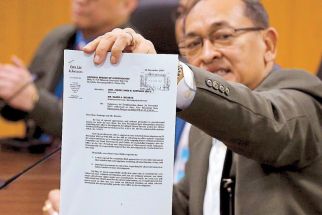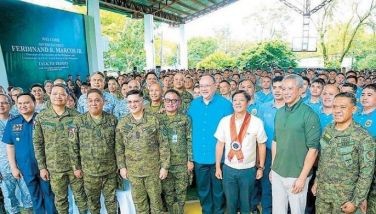Internet access allows Sarangani students to explore the world
March 30, 2006 | 12:00am
BAWING, General Santos City — The Internet is helping high school students here explore different worlds and opportunities far beyond the picturesque Sarangani Bay overlooking this small town, which is secluded though it is only 20 kilometers from the city proper.
Nisan Joy Pilar, who is graduating this year from the Bawing National High School, said surfing the Internet helped her decide what course to take up when she enrolls in college.
"I want to take up education and be a teacher," she said, full of the optimism and enthusiasm of someone looking forward to exploring new places and adventures.
"Through the Internet, I was able to do my research assignments better and I was also able to visit various websites offering information about career and job opportunities. Right now, I’m searching for a college or a university that I could enroll in and, hopefully, I can also apply for a scholarship," Pilar said in Filipino.
A typical school day for Pilar includes at least two hours on one of the school’s 10 Internet-connected computers, which were provided by the Computer Literacy and Internet Connection (CLIC) project of the United States Agency for International Development-Growth with Equity in Mindanao (USAID-GEM) program.
Ten more computers were donated by local government officials, which will be connected to the Internet this year.
Since there are no phone landlines in the area, the Internet access came through satellite last August.
"I wish there were more Internet-connected computer units for students so we could do our homework faster," said Joel Bensing, a second-year high school student who shares the 10 computers with 438 other students during school days.
"But we really appreciate it. Because of this facility, other worlds have opened for us, which would not have been possible if we only relied on the books that we have at the library since most of them are outdated, while the information we get from the Internet is very recent," he added.
Nethsabe Potayre, a classmate of Bernsing, said that the new facility has kept her interested in staying in school.
"Nakakahinayang hindi gamitin ang Internet (It would be a waste not to use the Internet). There is no other place in this town that has Internet access and being in touch with current events helps me sustain my interest in school. I enjoy seeing pictures and images of things we talk about during class lectures," she said.
A fisherman’s daughter, Potayre said she visits educational websites that provide reading and language exercises.
"I’ve been expanding my English vocabulary. Research has become easier and the amount of information I can get from Google, my favorite search engine, is just amazing," she said.
The CLIC project, which was implemented in 2004 under GEM II, is crucial in bridging the digital divide between students in "wired" cities and those in impoverished and conflict-ridden communities of Mindanao.
The CLIC project is spearheaded by GEM II, which works with the Department of Education (DepEd)-Autonomous Region in Muslim Mindanao (ARMM) and with several organizations such as the Ayala Foundation, to raise the level of computer literacy of teachers in the area. The program provides desktop computers, printers, hardware for the extended local area network, Internet access and training for public elementary and high school teachers within the ARMM and other areas of conflict in Mindanao.
As their counterpart contribution, recipient schools provide space for a computer laboratory and assign instructors to implement the computer training curriculum. After the first year, schools will start paying for the maintenance and repair of the computer units as well as the annual fee for the Internet connection. The project also include a one-week training on basic computer maintenance and troubleshooting for students and teachers.
Currently, there are more than 100 schools in Mindanao that have benefited from CLIC. These schools provide computer and Internet access to about 5,000 teachers and 100,000 high school students. USAID-GEM plans to add at least 100 new schools each year to its growing list of beneficiaries for the entire duration of the three-year CLIC project.
Right now, the project is undoubtedly making a difference in the lives of students in remote towns in Mindanao.
For instance, here in General Santos City, which is strategically located within the trading and economic center of South Cotabato, Sultan Kudarat, Sarangani and General Santos (Socsargen), the Internet connection provides a vital access to information on major foreign markets such as Brunei, Singapore, Malaysia, Indonesia, Australia, Pacific Islands, Japan, Hong Kong, Middle East, Continental Europe and the United States.
The poor coastal community of Bawing is composed mostly of marginal fishing families such as the Badjaos who live in houseboats clustered in moorings along Sarangani Bay. Their main livelihood is fishing, complemented with earnings from barter of fish products and farm produce like cassava and fruits.
"The CLIC project has succeeded in making students want to stay in school because the everyday learning experience opens up new possibilities for them," said Leonardo Genoguin, Bawing National High School principal. He said he is optimistic that the dropout rate would be lesser starting this year.
As in most poor communities, many high school students here drop out of school in their junior and senior years as they often have to leave town to work as household helpers or factory workers.
Genoguin explained that it is not uncommon during the tuna fishing season here for many of the male students, especially those belonging to cultural minorities, to go on school leave for a couple of weeks to join the tuna fleets heading off to Indonesia to catch tuna that would be processed in the six tuna canneries in General Santos City. Many of them never go back to school.
A critical component in making the CLIC project sustainable is the involvement of parents and teachers, who often initiate projects to raise funds for the computer laboratories.
"We were surprised that we didn’t need to convince parents about the need to invest in their children’s education. In fact, the parents have committed to contribute P15 a month to build up a fund to maintain the Internet connection and pay for electricity and other maintenance cost once the one-year CLIC support ends," said Genoguin.
About 30 minutes from Barangay Bawing is Barangay Kansas where children of seafarers experience the same problems. But with CLIC, there is a renewed enthusiasm for school work.
"Most of the parents here are subsistence farmers and fishermen and so when their children get older, they are expected to help out in their parents’ livelihood activities to feed younger siblings or to go to other towns and cities in the Visayas or Luzon to find work. Many just stop going to school when they finish their sophomore year," said Nemia Perez, principal of Kawas National High School.
But with her school now operating five Internet-connected computers from CILC, Perez said the students have shown more eagerness for taking on new academic challenges.
"Since our school was connected to the Internet, doing homework, especially those that require research is just a click away and our teachers must have noticed our improvement that they have been giving us tougher assignments," said Medelyn Sacil, a senior high school student.
It’s still too early to say what CLIC’s impact will be on students’ academic performance but for thousands of students like Pilar and Sacil, the project has given them the chance to entertain possibilities that not too long ago weren’t even in the realm of their imaginations.
Nisan Joy Pilar, who is graduating this year from the Bawing National High School, said surfing the Internet helped her decide what course to take up when she enrolls in college.
"I want to take up education and be a teacher," she said, full of the optimism and enthusiasm of someone looking forward to exploring new places and adventures.
"Through the Internet, I was able to do my research assignments better and I was also able to visit various websites offering information about career and job opportunities. Right now, I’m searching for a college or a university that I could enroll in and, hopefully, I can also apply for a scholarship," Pilar said in Filipino.
A typical school day for Pilar includes at least two hours on one of the school’s 10 Internet-connected computers, which were provided by the Computer Literacy and Internet Connection (CLIC) project of the United States Agency for International Development-Growth with Equity in Mindanao (USAID-GEM) program.
Ten more computers were donated by local government officials, which will be connected to the Internet this year.
Since there are no phone landlines in the area, the Internet access came through satellite last August.
"I wish there were more Internet-connected computer units for students so we could do our homework faster," said Joel Bensing, a second-year high school student who shares the 10 computers with 438 other students during school days.
"But we really appreciate it. Because of this facility, other worlds have opened for us, which would not have been possible if we only relied on the books that we have at the library since most of them are outdated, while the information we get from the Internet is very recent," he added.
Nethsabe Potayre, a classmate of Bernsing, said that the new facility has kept her interested in staying in school.
"Nakakahinayang hindi gamitin ang Internet (It would be a waste not to use the Internet). There is no other place in this town that has Internet access and being in touch with current events helps me sustain my interest in school. I enjoy seeing pictures and images of things we talk about during class lectures," she said.
A fisherman’s daughter, Potayre said she visits educational websites that provide reading and language exercises.
"I’ve been expanding my English vocabulary. Research has become easier and the amount of information I can get from Google, my favorite search engine, is just amazing," she said.
The CLIC project, which was implemented in 2004 under GEM II, is crucial in bridging the digital divide between students in "wired" cities and those in impoverished and conflict-ridden communities of Mindanao.
The CLIC project is spearheaded by GEM II, which works with the Department of Education (DepEd)-Autonomous Region in Muslim Mindanao (ARMM) and with several organizations such as the Ayala Foundation, to raise the level of computer literacy of teachers in the area. The program provides desktop computers, printers, hardware for the extended local area network, Internet access and training for public elementary and high school teachers within the ARMM and other areas of conflict in Mindanao.
As their counterpart contribution, recipient schools provide space for a computer laboratory and assign instructors to implement the computer training curriculum. After the first year, schools will start paying for the maintenance and repair of the computer units as well as the annual fee for the Internet connection. The project also include a one-week training on basic computer maintenance and troubleshooting for students and teachers.
Currently, there are more than 100 schools in Mindanao that have benefited from CLIC. These schools provide computer and Internet access to about 5,000 teachers and 100,000 high school students. USAID-GEM plans to add at least 100 new schools each year to its growing list of beneficiaries for the entire duration of the three-year CLIC project.
Right now, the project is undoubtedly making a difference in the lives of students in remote towns in Mindanao.
For instance, here in General Santos City, which is strategically located within the trading and economic center of South Cotabato, Sultan Kudarat, Sarangani and General Santos (Socsargen), the Internet connection provides a vital access to information on major foreign markets such as Brunei, Singapore, Malaysia, Indonesia, Australia, Pacific Islands, Japan, Hong Kong, Middle East, Continental Europe and the United States.
The poor coastal community of Bawing is composed mostly of marginal fishing families such as the Badjaos who live in houseboats clustered in moorings along Sarangani Bay. Their main livelihood is fishing, complemented with earnings from barter of fish products and farm produce like cassava and fruits.
"The CLIC project has succeeded in making students want to stay in school because the everyday learning experience opens up new possibilities for them," said Leonardo Genoguin, Bawing National High School principal. He said he is optimistic that the dropout rate would be lesser starting this year.
As in most poor communities, many high school students here drop out of school in their junior and senior years as they often have to leave town to work as household helpers or factory workers.
Genoguin explained that it is not uncommon during the tuna fishing season here for many of the male students, especially those belonging to cultural minorities, to go on school leave for a couple of weeks to join the tuna fleets heading off to Indonesia to catch tuna that would be processed in the six tuna canneries in General Santos City. Many of them never go back to school.
A critical component in making the CLIC project sustainable is the involvement of parents and teachers, who often initiate projects to raise funds for the computer laboratories.
"We were surprised that we didn’t need to convince parents about the need to invest in their children’s education. In fact, the parents have committed to contribute P15 a month to build up a fund to maintain the Internet connection and pay for electricity and other maintenance cost once the one-year CLIC support ends," said Genoguin.
About 30 minutes from Barangay Bawing is Barangay Kansas where children of seafarers experience the same problems. But with CLIC, there is a renewed enthusiasm for school work.
"Most of the parents here are subsistence farmers and fishermen and so when their children get older, they are expected to help out in their parents’ livelihood activities to feed younger siblings or to go to other towns and cities in the Visayas or Luzon to find work. Many just stop going to school when they finish their sophomore year," said Nemia Perez, principal of Kawas National High School.
But with her school now operating five Internet-connected computers from CILC, Perez said the students have shown more eagerness for taking on new academic challenges.
"Since our school was connected to the Internet, doing homework, especially those that require research is just a click away and our teachers must have noticed our improvement that they have been giving us tougher assignments," said Medelyn Sacil, a senior high school student.
It’s still too early to say what CLIC’s impact will be on students’ academic performance but for thousands of students like Pilar and Sacil, the project has given them the chance to entertain possibilities that not too long ago weren’t even in the realm of their imaginations.
BrandSpace Articles
<
>
- Latest
- Trending
Trending
Latest
Trending
Latest
Recommended
November 25, 2024 - 12:00am
November 24, 2024 - 12:00am






























